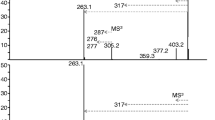Abstract
Objective
We characterized the kinetics of indomethacin glucuronidation by recombinant UDP-glucuronosyltransferase (UGT) isozymes and human liver microsomes (HLM) and identified the human UGT isozymes involved.
Methods
Indomethacin glucuronidation was investigated using HLM and recombinant human UGT isozymes. Human UGTs involved in indomethacin glucuronidation were assessed in kinetic studies, chemical inhibition studies, and correlation studies.
Results
Among the UGT isozymes investigated, UGT1A1, 1A3, 1A9, and 2B7 showed glucuronidation activity for indomethacin, with UGT1A9 possessing the highest activity, followed by UGT2B7. Glucuronidation of indomethacin by recombinant UGT1A9 and 2B7 showed substrate inhibition kinetics with K m values of 35 and 32 μM, respectively. The glucuronidation of indomethacin was significantly correlated with morphine 3OH-glucuronidation (r = 0.69, p < 0.05) and 3′-azido-3′-deoxythymidine glucuronidation (r = 0.82, p < 0.05), a reaction mainly catalyzed by UGT2B7. Propofol inhibited indomethacin glucuronidation in HLM with an IC50 value of 248 μM, which is between the IC50 value in recombinant UGT1A9 (106 μM) and UGT2B7 (> 400 μM).
Conclusions
These findings suggest that UGT2B7 plays a predominant role in indomethacin glucuronidation in the human liver and that UGT1A9 is partially involved.






Similar content being viewed by others
References
Vree TB, van den Biggelaar-Martea M, Verwey-van Wissen CP (1993) Determination of indomethacin, its metabolites and their glucuronides in human plasma and urine by means of direct gradient high-performance liquid chromatographic analysis. Preliminary pharmacokinetics and effect of probenecid. J Chromatogr 616:271–282
Hucker HB, Zacchei AG, Cox SV, Brodie DA, Cantwell NHR (1966) Studies on the absorption, distribution and excretion of indomethacin in various species. J Pharmacol Exp Ther 153:237–249
Duggan DE, Hogans AF, Kwan KC, McMahon FG (1972) The metabolism of indomethacin in man. J Pharmacol Exp Ther 181:563–575
Kwan KC, Breault GO, Umbenhauer ER, McMahon FG, Duggan DE (1976) Kinetics of indomethacin absorption, elimination, and enterohepatic circulation in man. J Pharmacokinet Biop 4:255–280
Van Hecken A, Verbesselt R, Tjandra-Maga TB, De Schepper PJ (1989) Pharmacokinetic interaction between indomethacin and diflunisal. Eur J Clin Pharmacol 36:507–512
Kuehl GE, Lampe JW, Potter JD, Bigler J (2005) Glucuronidation of nonsteroidal anti-inflammatory drugs: identifying the enzymes responsible in human liver microsomes. Drug Metab Dispos 33:1027–1035
Mano Y, Usui T, Kamimura H (2005) In vitro inhibitory effects of non-steroidal antiinflammatory drugs on UDP-glucuronosyltransferase 1A1-catalysed estradiol 3β-glucuronidation in human liver microsomes. Biopharm Drug Dispos 26:35–39
Mano Y, Usui T, Kamimura H (2006) In vitro inhibitory effects of non-steroidal antiinflammatory drugs on UDP-glucuronosyltransferase 1A9-catalysed 4-methylumbelliferone glucuronidation by recombinant human UGT1A9 – potent inhibition by niflumic acid. Biopharm Drug Dispos 27:1–6
Mano Y, Usui T, Kamimura H (2004) Effects of β-estradiol and propofol on the 4-methylumbelliferone glucuronidation by recombinant human UGT isozymes 1A1, 1A8 and 1A9. Biopharm Drug Dispos 25:339–344
Mano Y, Usui T, Kamimura H (2006) Identification of human UDP-glucuronosyltransferase responsible for the glucuronidation of niflumic acid in human liver. Pharm Res 23:1502–1508
Court MH, Krishnaswamy S, Hao Q, Duan SX, Patten CJ, Von Moltke LL, Greenblatt DJ (2003) Evaluation of 3′-azido-3′-deoxythymidine, morphine, and codeine as probe substrates for UDP-glucuronosyltransferase 2B7 (UGT2B7) in human liver microsomes: specificity and influence of the UGT2B7*2 polymorphism. Drug Metab Dispos 31:1125–1133
Mano Y, Usui T, Kamimura H (2006) In vitro drug interaction between diflunisal and indomethacin via glucuronidation in humans. Biopharm Drug Dispos 27:267–273
Mano Y, Usui T, Kamimura H (2007) Inhibitory potential of nonsteroidal anti-inflammatory drugs on UDP-glucuronosyltransferase 2B7 in human liver microsomes. Eur J Clin Pharmacol (in press) DOI 10.1007/s00228-006-0241-9
Tukey RH, Strassburg CP (2000) Human UDP-glucuronosyltransferases: metabolism, expression, and disease. Annu Rev Pharmacol Toxicol 40:581–616
Burchell B, Brierley CH, Rance D (1995) Specificity of human UDP-glucuronosyltransferases and xenobiotic glucuronidation. Life Sci 57:1819–1831
Senafi SB, Clarke DJ, Burchell B (1994) Investigation of the substrate specificity of a cloned expressed human bilirubin UDP-glucuronosyltransferase: UDP-sugar specificity and involvement in steroid and xenobiotic glucuronidation. Biochem J 303:233–240
de Wildt SN, Kearns GL, Leeder JS, van den Anker JN (1999) Glucuronidation in humans. Clin Pharmacokinet 36:439–452
Bowalgaha K, Elliot DJ, Mackenzie PI, Knights KM, Swedmark S, Miners JO (2005) S-Naproxen and desmethylnaproxen glucuronidation by human liver microsomes and recombinant human UDP-glucuronosyltransferases (UGT): role of UGT2B7 in the elimination of naproxen. Br J Clin Pharmacol 60:423–433
King C, Tang W, Ngui J, Tephly T, Braun M (2001) Characterization of rat and human UDP-glucuronosyltransferases responsible for the in vitro glucuronidation of diclofenac. Toxicol Sci 61:49–53
Tougou K, Gotou H, Ohno Y, Nakamura A (2004) Stereoselective glucuronidation and hydroxylation of etodolac by UGT1A9 and CYP2C9 in man. Xenobiotica 34:449–461
Ebner T, Burchell B (1993) Substrate specificities of two stably expressed human liver UDP-glucuronosyltransferases of the UGT1 gene family. Drug Metab Dispos 21:50–55
Court MH, Duan SX, von Moltke LL, Greenblatt DJ, Patten CJ, Miners JO, Mackenzie PI (2001) Interindividual variability in acetaminophen glucuronidation by human liver microsomes: identification of relevant acetaminophen UDP-glucuronosyltransferase isoforms. J Pharmacol Exp Ther 299:998–1006
Author information
Authors and Affiliations
Corresponding author
Rights and permissions
About this article
Cite this article
Mano, Y., Usui, T. & Kamimura, H. Contribution of UDP-glucuronosyltransferases 1A9 and 2B7 to the glucuronidation of indomethacin in the human liver. Eur J Clin Pharmacol 63, 289–296 (2007). https://doi.org/10.1007/s00228-007-0261-0
Received:
Accepted:
Published:
Issue Date:
DOI: https://doi.org/10.1007/s00228-007-0261-0




